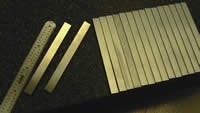CNC Grinding Cell Cuts Lead Times For Progressive Die Maker
In a search for ways to to turn grinding work around faster, this company decided to make better use of its CNC surface grinder, which proved successful.
Share



ECi Software Solutions, Inc.
Featured Content
View More






The grinding department at L. H. Carbide (Fort Wayne, Indiana) is no stranger to CNC grinding. But CNC equipment has tended to be under-used here. The shop machines carbide components to accuracies of ±0.0001 inch that are used in the company's complex, progressive stamping dies. Usually these components are machined in such small batches that the company can't justify a large investment in NC programming time.
However, the grinding staff has recently been taking a second and a third look at all of its equipment and procedures. Under pressure from overseas competitors making cheaper dies, the company is fighting back by achieving tighter delivery times, and the grinding department has been feeling the squeeze. Kevin Abbott, who manages the department, says the personnel have been searching for ways to turn around grinding work faster without a large investment in new equipment. One resolution they made early on was not to allow the thought, "We've never done this before," to stand in the way of a good solution.
Among the equipment in the shop that deserved a second look was a 2-year-old CNC surface grinder from Jones & Shipman (U.S. office in Farmington, Connecticut). This machine's conversational control keeps setup time low by simplifying NC programming. Also, the machine is capable of a higher material removal rate than comparable manual grinders in the shop. The challenge to shop personnel was to find a way to make better use of this machine.
Two other machines provided to be the answer. The shop mated this grinder with an older CNC surface grinder in the shop, and then the company purchased an additional Jones & Shipman machine. The result is a three-machine CNC grinding cell that has fundamentally changed the way this shop runs certain parts.
The company's carbide die components have traditionally begun as molded preforms. L. H. Carbide's component designs go to a vendor in Austria that supplies these molded parts. When the preforms arrive, they are ground to precise dimensions. Waiting for the preform to come routinely adds 2 to 3 weeks to any job.
But today, the three-machine cell makes it possible to perform considerably more grinding on each part, and to do so efficiently, because each machine can grind a different piece at the same time. An operator sets up three machines for three sequential operations and then transfers work from machine to machine as each cycle finishes. This process is cheaper because one operator can easily oversee all of the equipment. It's also much faster. When the three operations consist of rough, semi-finish and finish grinding, a component can be machined from a raw, off-the-shelf block of carbide instead of from a preform. As a result, there is no need to wait for the shipment from the preform vendor.
Not every die component is appropriate for production in this way, but the shop now considers the cell for every job that has enough pieces to justify the multi-machine approach. In part because the ease of programming results in short setups, a job with as few as ten pieces might be run through this cell more efficiently than the same ten pieces could be run on a manual grinder. Sometimes the shop changes over the cell for a new part number as frequently as three times in one shift.
The newest CNC surface grinder in the cell is Jones & Shipman's "524 Easy" machine, which uses a 10-inch wheel and a 200-mm by 500-mm table. Like the shop's earlier Jones & Shipman machine, this one achieves a high material removal rate compared to other machines in the shop with the same size and power.
One feature of this latest grinder was customized for L. H. Carbide. Mr. Abbott explained to the grinding machine maker that he wanted to be able to run parts that require grinding on multiple faces in a single cycle, instead of having to create a different program for each face. The company responded by equipping L. H. Carbide's machine with software that permits a dwell to be added to the program. The operator can then rotate the part to a different orientation before the grinding cycle resumes.
Read Next
Building Out a Foundation for Student Machinists
Autodesk and Haas have teamed up to produce an introductory course for students that covers the basics of CAD, CAM and CNC while providing them with a portfolio part.
Read MoreRegistration Now Open for the Precision Machining Technology Show (PMTS) 2025
The precision machining industry’s premier event returns to Cleveland, OH, April 1-3.
Read More5 Rules of Thumb for Buying CNC Machine Tools
Use these tips to carefully plan your machine tool purchases and to avoid regretting your decision later.
Read More







.png;maxWidth=150)



























.jpg;maxWidth=300;quality=90)








